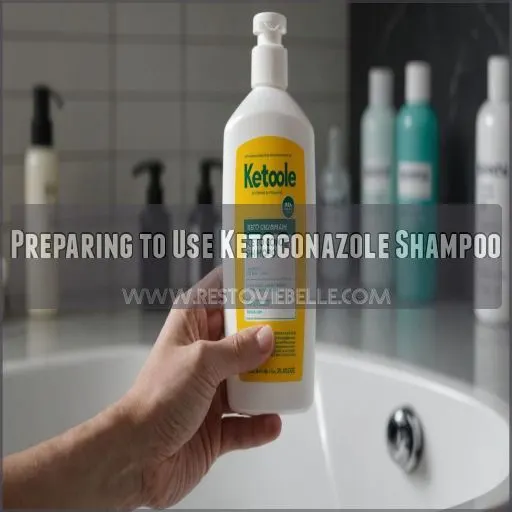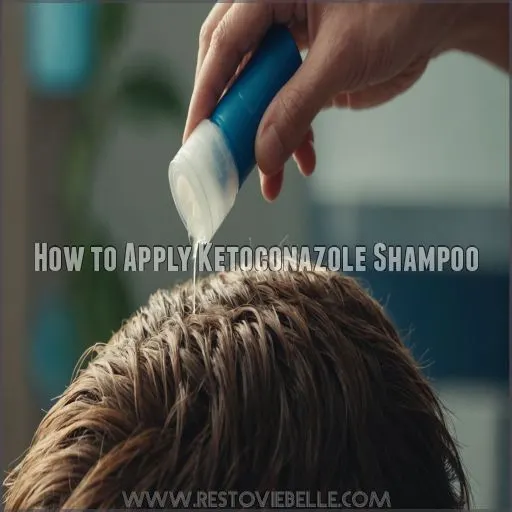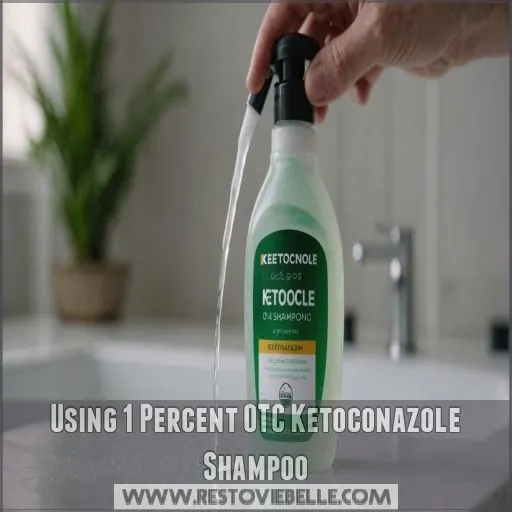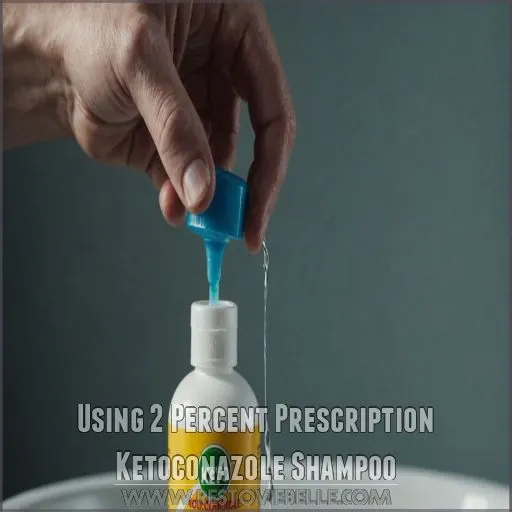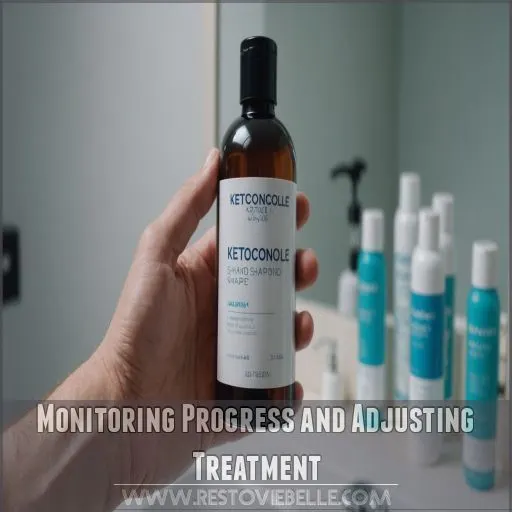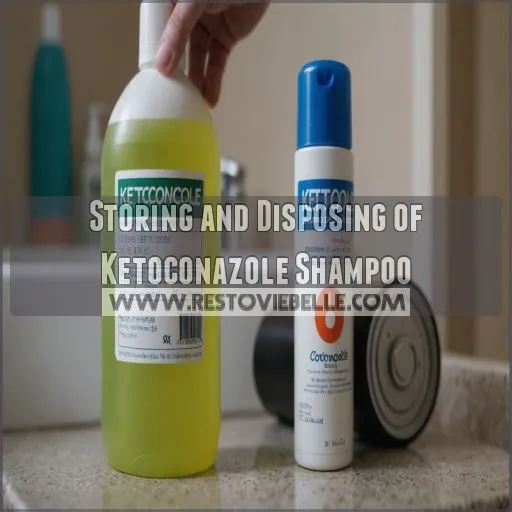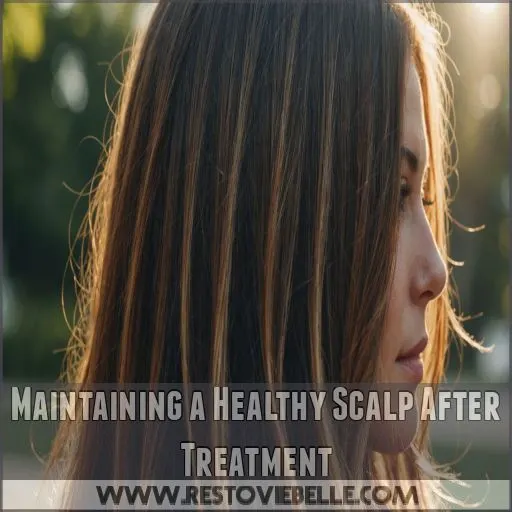This site is supported by our readers. We may earn a commission, at no cost to you, if you purchase through links.

First, wet your hair thoroughly, and then massage a generous amount of shampoo into your scalp.
Make sure you work up a good lather—it’s like a bubble party for yeast—and let it sit for about five minutes.
Rinse well to avoid any pesky dryness.
If you’re dealing with dandruff, use the 1% version every 3-4 days.
For stubborn fungal foes, the 2% might be your go-to.
And remember, if your scalp throws a tantrum with irritation, talk to your doctor.
Curious about more tips? Keep reading!
Table Of Contents
- Key Takeaways
- Preparing to Use Ketoconazole Shampoo
- How to Apply Ketoconazole Shampoo
- Using 1 Percent OTC Ketoconazole Shampoo
- Using 2 Percent Prescription Ketoconazole Shampoo
- Managing Side Effects and Allergic Reactions
- Combining Ketoconazole Shampoo With Other Treatments
- Monitoring Progress and Adjusting Treatment
- Storing and Disposing of Ketoconazole Shampoo
- Maintaining a Healthy Scalp After Treatment
- Frequently Asked Questions (FAQs)
- Do I use regular shampoo after ketoconazole shampoo?
- How many times a week should you use ketoconazole shampoo?
- How long does it take for ketoconazole shampoo to work?
- How long should I leave ketoconazole shampoo on my scalp?
- Can I use ketoconazole shampoo on my entire body?
- Will ketoconazole shampoo interact with other medications Im taking?
- How often should I use ketoconazole shampoo for best results?
- Is ketoconazole shampoo safe to use during pregnancy or breastfeeding?
- Conclusion
Key Takeaways
- Choose the Right Shampoo Concentration and Frequency: Whether you need a gentle nudge or a power wash, pick a 1% OTC for dandruff or a 2% prescription for tougher issues. Keep that rhythm—2-3 times a week should work wonders!
- Apply with Flair for Best Results: Wet your hair, lather up like you’re at a bubble rave, and leave it on for a "sing-along" five minutes. It’s your own mini spa for the scalp—just rinse thoroughly afterward!
- Watch Out for Reactions and Side Effects: Stay alert! If your scalp starts acting like a drama queen with irritation or a rash, hit the pause button and check in with your doctor. Prevention is better than a scalp disaster flick.
- Maintain Your Scalp’s Happily-Ever-After: After a ketoconazole kick, switch to a gentle shampoo without harsh chemicals, and munch on scalp-friendly foods—your hair will thank you with flourishing strands!
Preparing to Use Ketoconazole Shampoo
Before using ketoconazole shampoo, it’s important to understand the different concentrations and pick the one that suits your scalp needs.
Don’t forget to check in with your doctor and mention any allergies or current medications—let’s avoid turning your scalp into a science experiment!
Understanding Ketoconazole Shampoo Concentrations
Ready to tackle those pesky scalp issues? Understanding ketoconazole shampoo concentrations is key.
The 1% over-the-counter (OTC) option is great for dandruff treatment, while the 2% prescription strength targets stubborn infections.
It’s like choosing between a gentle shower and a power wash!
Choosing the Right Ketoconazole Shampoo for Your Needs
When choosing a ketoconazole shampoo, consider these key factors:
- Concentration – OTC shampoos typically have 1% ketoconazole, while prescriptions range from 2-4%.
- Condition – 1% is great for dandruff, while 2% or higher may be needed for fungal infections like tinea versicolor.
- Brand – Nizoral is a popular OTC option, while Ketozal and Ketozolin are common prescription brands.
- Your doctor’s recommendation – they can help determine the right strength and formulation for your specific needs.
Consulting a Doctor Before Using Ketoconazole Shampoo
Before diving into ketoconazole shampoo, save yourself a headache by checking in with your doctor.
It’s critical, especially if you’re dealing with pregnancy, breastfeeding, or existing scalp conditions.
They’ll help you understand potential side effects and alternative treatments.
Trust me, a quick chat can prevent an allergic reaction or the wrong prescription label from making your scalp the star of a disaster film.
Informing Your Healthcare Provider About Allergies and Medications
Give your healthcare provider the lowdown on any drug interactions or recent skin sensitivities.
It’s important to tell them about your medical history, previous treatments, and prescription details, whether it’s ketoconazole or others like salicylic acid, coal tar, tea tree oil, or pyrithione zinc.
After all, forewarned is forearmed, and this makes sure the right scalp solution doesn’t go off the rails!
How to Apply Ketoconazole Shampoo
To get the most out of ketoconazole shampoo, you’ve got to master the art of lathering like a pro.
Start with wet hair, a good scrub, and a five-minute patience break before rinsing—you’ll be a step closer to a flake-free scalp!
Washing Hands Before and After Applying
Wash your hands thoroughly before and after applying ketoconazole shampoo.
This helps prevent the spread of germs and reduces the risk of skin irritation.
Always follow proper hygiene practices when using antifungal medications.
Keeping your hands clean is a simple yet essential step in using ketoconazole shampoo safely and effectively.
Applying Ketoconazole Shampoo to Wet Hair
Once your hands are squeaky clean, it’s time for action.
Grab your ketoconazole shampoo and apply it generously to wet hair.
Pretend you’re a masseuse, giving your scalp a gentle massage.
This helps the shampoo reach every nook and cranny, tackling that pesky seborrheic dermatitis or tinea capitis.
Remember, you’re the boss here, ensuring your scalp gets the TLC it deserves!
Lathering and Rinsing Ketoconazole Shampoo
You’ve just applied ketoconazole shampoo to your wet hair; now, let’s talk lathering technique. Aim for a rich, bubbly foam that covers every strand—think of it as giving your hair a bubbly hug.
After a good lather, rinse thoroughly, making sure no suds are left behind. This helps prevent hair dryness, scalp irritation, or unexpected changes in hair color.
Leaving Ketoconazole Shampoo on for the Recommended Time
The impact of timing is key when using ketoconazole shampoo.
After lathering, let it soak on your scalp for around five minutes—perfect time to contemplate life’s mysteries or belt out your shower playlist.
Stick to this duration to give it a fighting chance against those pesky scalp invaders.
Consult your care team if you’re unsure about the specifics.
Using 1 Percent OTC Ketoconazole Shampoo
If you’re dealing with dandruff or seborrheic dermatitis, the over-the-counter 1% ketoconazole shampoo can be your go-to solution.
Just lather it up, let it soak in for a few minutes, and rinse – repeat this routine every 3-4 days for up to 8 weeks to see those flakes and itchiness disappear.
Treating Dandruff and Seborrheic Dermatitis
After applying ketoconazole shampoo, treating dandruff and seborrheic dermatitis becomes a breeze!
Unmasking the enemy behind those pesky flakes, the shampoo skillfully targets the yeast lurking on your scalp.
Think of it as your scalp’s secret weapon against dry, itchy neighbors.
As you lather, picture a battleground where only your scalp health remains victorious.
Embrace this ally for resilient, beautiful hair.
Frequency of Use for 1 Percent OTC Ketoconazole Shampoo
You’re tackling dandruff and seborrheic dermatitis, and you’re wondering how often to use that 1% ketoconazole shampoo, right?
Lathering up every three to four days should do the trick for the healthiest scalp possible—like giving a rebel without a cause a snug new helmet.
Stick with this frequency, and you’ll keep those flakes at bay!
Duration of Treatment for 1 Percent OTC Ketoconazole Shampoo
You’ve got your hands on 1% OTC ketoconazole shampoo—great choice!
So, how long should you use it?
Typically, aim for a dandruff treatment time of up to 8 weeks, washing every 3-4 days.
Think of it like telling those pesky scalp flakes, "Pack your bags for a long trip!"
Stay vigilant, and watch for scalp improvement over time.
Using 2 Percent Prescription Ketoconazole Shampoo
If your scalp condition requires a stronger treatment, your doctor may prescribe a 2% ketoconazole shampoo.
This potent formula can tackle stubborn fungal infections like tinea versicolor, so follow your doctor’s instructions closely for best results.
Treating Fungal Infections and Tinea Versicolor
Tackling fungal infections like tinea versicolor can feel like battling gremlins on your scalp.
It’s time to bring out the big guns: 2% prescription ketoconazole shampoo.
This potent treatment option is like the hero in a blockbuster, swooping in to handle pesky fungi.
While considering alternative remedies, remember prevention tips to keep your scalp fungus-free, like avoiding hair dye irritation.
Frequency of Use for 2 Percent Prescription Ketoconazole Shampoo
Using 2 percent prescription strength ketoconazole shampoo, you’ll want to follow your doctor’s advice, like a navigator with a treasure map.
Typically, it’s applied twice a week to tackle these nagging fungal infections.
Duration of Treatment for 2 Percent Prescription Ketoconazole Shampoo
A typical duration for using 2% prescription ketoconazole shampoo is around 2 to 4 weeks, depending on your doctor’s advice.
Think of it as a spa retreat for your scalp, giving it the TLC it needs to fend off fungi.
Practice best practices by following your doctor’s guidance closely.
If things don’t improve after the treatment length, consider revisiting your healthcare provider.
Managing Side Effects and Allergic Reactions
While ketoconazole shampoo is generally well-tolerated, you may experience some common side effects like scalp irritation or dryness, which can be especially concerning after a bleaching treatment. like scalp irritation.
Allergic reaction, so be sure to watch for signs and contact your doctor right away if that happens.
Common Side Effects of Ketoconazole Shampoo
When you’re using 2% ketoconazole shampoo, expect some common side effects like hair texture changes, scalp dryness, or a touch of itching or burning. You can learn more about potential side effects from using anti-dandruff shampoos here.
These side issues are usually more of a nuisance than a nightmare.
Picture them as that pesky fly at a picnic—annoying but manageable.
If anything feels off, don’t hesitate to check in with your healthcare provider.
Severe Side Effects and Allergic Reactions
Ketoconazole users, beware of severe side effects like skin reactions, unexplained hair loss, or, heaven forbid, breathing issues.
If these strike, it’s definitely time to hit the pause button and seek medical advice pronto.
While such reactions are rare, knowing they exist can keep you calm and in control.
What to Do in Case of an Allergic Reaction
Finding yourself dealing with allergy symptoms like itching or swelling isn’t anyone’s idea of fun.
First, stop using the shampoo—your scalp’s SOS call!
Reach out and contact your doctor pronto. Seeking help isn’t a sign of weakness; it’s a wise move.
Identify triggers with your doctor’s help, and reconnect with smooth, irritation-free scalp days pronto.
Combining Ketoconazole Shampoo With Other Treatments
Ketoconazole shampoo can be combined with other treatments to tackle your scalp condition more effectively.
Just be sure to check with your doctor before mixing medications or using multiple products on your scalp.
Using Ketoconazole Shampoo With Other Shampoos
Ever wonder about the frequency of using different shampoos alongside ketoconazole? It’s all about balance!
Stick to ketoconazole for scalp issues, and switch to your regular gentle shampoo to keep hair texture in check, like a residue-free dreadlock shampoo.
Try alternating days to maintain effectiveness and safety.
Check out various brands for alternatives, because let’s face it, variety is the spice of life!
Combining Ketoconazole Shampoo With Medications
Mixing shampoos can feel like a juggling act! When taking other medications, check for interactions with ketoconazole shampoo to keep your routine safe.
- Talk to your doctor about your current medications.
- Time your shampoo use wisely around doses.
- Keep an eye on dosage changes.
- Monitor any unusual reactions, and you’re golden!
Using Ketoconazole Shampoo With Other Scalp Treatments
Juggling ketoconazole with other scalp treatments can be like managing a circus act—balance is key. Don’t overdo it.
Ketoconazole shampoos, known for fighting dandruff and hair loss, work best without extra drama.
If you’re experimenting with alternatives, focus on scalp health. Mixing too much might lead to chaos, not control.
Clear communication with your dermatologist keeps things safe and sound.
Monitoring Progress and Adjusting Treatment
Closely monitoring your scalp condition is key to ensuring ketoconazole shampoo is working effectively.
If your symptoms don’t improve within a month, don’t hesitate to consult your doctor – they can help adjust the frequency or concentration to get your scalp back on track.
Tracking Changes in Your Scalp Condition
As you track your scalp’s progress, keep an eye on improvements like itch reduction, fewer flakes, and changes in hair texture.
Think of it as checking your plants for growth.
Introduce a little humor: if your scalp’s still snowy after weeks, maybe it’s time to contact your "scalp gardener."
Dryness levels should also gradually balance.
Stay observant!
Adjusting the Frequency or Concentration of Ketoconazole Shampoo
After tracking changes in your scalp condition, consider tweaking that beauty regimen.
Is dandruff acting like an uninvited guest or is your scalp sensitivity raising a ruckus?
Adjust the shampoo’s frequency or concentration to make it behave!
Pay attention to treatment duration and condition improvement.
Consulting a Doctor if Your Condition Does Not Improve
If your scalp’s a stubborn mule and ketoconazole doesn’t whip it into shape, it’s time to consult a doctor.
They can offer alternative treatments to tackle persistent symptoms or fungal infections.
Don’t let your scalp’s rebellion bring you down!
Doctors can provide expert advice and help steer your scalp health in the right direction.
Storing and Disposing of Ketoconazole Shampoo
Proper storage and disposal of your ketoconazole shampoo are just as important as using it correctly.
Keep the shampoo at room temperature.
Don’t forget to safely dispose of any leftover medication once it expires.
Storing Ketoconazole Shampoo at Room Temperature
Now that you’re monitoring progress, let’s chat about storing ketoconazole shampoo to maintain its mojo.
Keep it at room temperature between 68°F and 77°F in a proper container.
Steer clear of direct sunlight exposure to preserve its shelf life.
Treat it like a delicate cupcake—no need for a fridge, just a cozy, dry corner.
Disposing of Unused or Expired Ketoconazole Shampoo
While storing ketoconazole shampoo properly is important, don’t forget about safe disposal practices for unused or expired bottles.
Just like you’d toss that questionable milk carton, make sure you’re following proper disposal methods.
Check local disposal regulations to stay compliant.
Using environmentally-friendly disposal ensures you’re not pouring your problems down the drain, but instead handling them responsibly.
Maintaining a Healthy Scalp After Treatment
Keeping your scalp healthy after using ketoconazole shampoo isn’t rocket science—just follow a few simple steps for managing underlying skin conditions.
Embrace gentle shampoos, steer clear of harsh chemicals, and remember that a balanced diet helps your scalp as much as it does your waistline.
Using a Gentle Shampoo After Ketoconazole Treatment
After using ketoconazole shampoo, why not treat your scalp to a gentle, nourishing shampoo? Look for formulas that are free of sulfates, parabens, and harsh chemicals. This can help restore moisture and maintain a healthy scalp environment, preventing further irritation. Your hair will thank you for the extra TLC!
After using ketoconazole shampoo, why not treat your scalp to a gentle, nourishing shampoo? Look for formulas that are free of sulfates, parabens, and harsh chemicals. This can help restore moisture and maintain a healthy scalp environment, preventing further irritation. Your hair will thank you for the extra TLC!
- Opt for a sulfate-free, pH-balanced shampoo.
- Avoid products with alcohol, fragrances, or dyes.
- Consider a shampoo with soothing ingredients like aloe vera or chamomile.
Avoiding Harsh Chemicals and Dyes
Switching to gentle shampoos is a great move, and avoiding harsh chemicals and dyes is even better.
Picture your scalp as a delicate plant; it thrives with a gentle touch.
Consider natural hair care options or DIY remedies to keep it happy.
Opt for hair dye alternatives that are kinder, ensuring your scalp health remains spot-on.
Keep those tresses flourishing!
Maintaining a Balanced Diet for a Healthy Scalp
Avoid harsh chemicals; nourish from within. A balanced diet can do wonders for your scalp!
Consider adding:
- Scalp-friendly foods: Think fresh veggies and fruits.
- Hair vitamins: Get your biotin and vitamin E.
- Dietary zinc: Important for strength and growth.
- Omega-3s: Found in fish or flaxseed.
- A nutrient deficiency? Consult a physician. Your hair and scalp will thank you!
Frequently Asked Questions (FAQs)
Do I use regular shampoo after ketoconazole shampoo?
It’s typically unnecessary to use regular shampoo after ketoconazole shampoo, but you can condition the ends of your hair if needed.
You’re doing great; this isn’t a Broadway show, so no need for an encore!
How many times a week should you use ketoconazole shampoo?
You should use ketoconazole shampoo about twice a week.
It’s like a dance—too much, and you’ll step on toes; too little, and you’ll shuffle aimlessly.
Keep the rhythm for best results and scalp happiness!
How long does it take for ketoconazole shampoo to work?
You’ll start seeing results with ketoconazole shampoo in about 2 to 4 weeks.
If your pesky dandruff or itching hasn’t packed its bags by then, it’s time to chat with your doctor for a plan B.
How long should I leave ketoconazole shampoo on my scalp?
Ever felt like you’re juggling too many hats and just need one clear answer?
Simply leave ketoconazole shampoo on your scalp for about five minutes.
It’s like giving your scalp a mini spa treatment.
Feel in control!
Can I use ketoconazole shampoo on my entire body?
While ketoconazole shampoo is primarily for the scalp, it can treat fungal infections on other skin areas.
Just don’t use it as your new body wash!
Always patch test and consult your doctor first.
Will ketoconazole shampoo interact with other medications Im taking?
Worried about mixing potions? Ketoconazole shampoo generally doesn’t interact with most medications because it’s used topically.
Still, chat with your doc to be on the safe side—especially if you’re juggling several prescriptions, just to be sure!
How often should I use ketoconazole shampoo for best results?
For best results, use ketoconazole shampoo every 3-4 days.
Stick to this routine for up to 8 weeks, and you’ll start seeing improvements in your scalp condition.
Just don’t overdo it – moderation is key!
Is ketoconazole shampoo safe to use during pregnancy or breastfeeding?
Use ketoconazole shampoo cautiously during pregnancy.
It’s okay if the benefit outweighs risks, but chat with your doctor.
For nursing moms, it’s generally safe, but avoid using it on the breast to prevent infant exposure (Source).
Conclusion
Imagine a garden of healthy, vibrant hair sprouting from a well-nourished scalp.
That’s the goal when you learn how to use ketoconazole shampoo effectively.
With its balancing act against dandruff and fungi, proper application is key.
Select the right concentration, follow application steps, monitor progress, and maintain healthy habits afterward.
Mastering these steps brings you closer to scalp serenity and lively locks.

